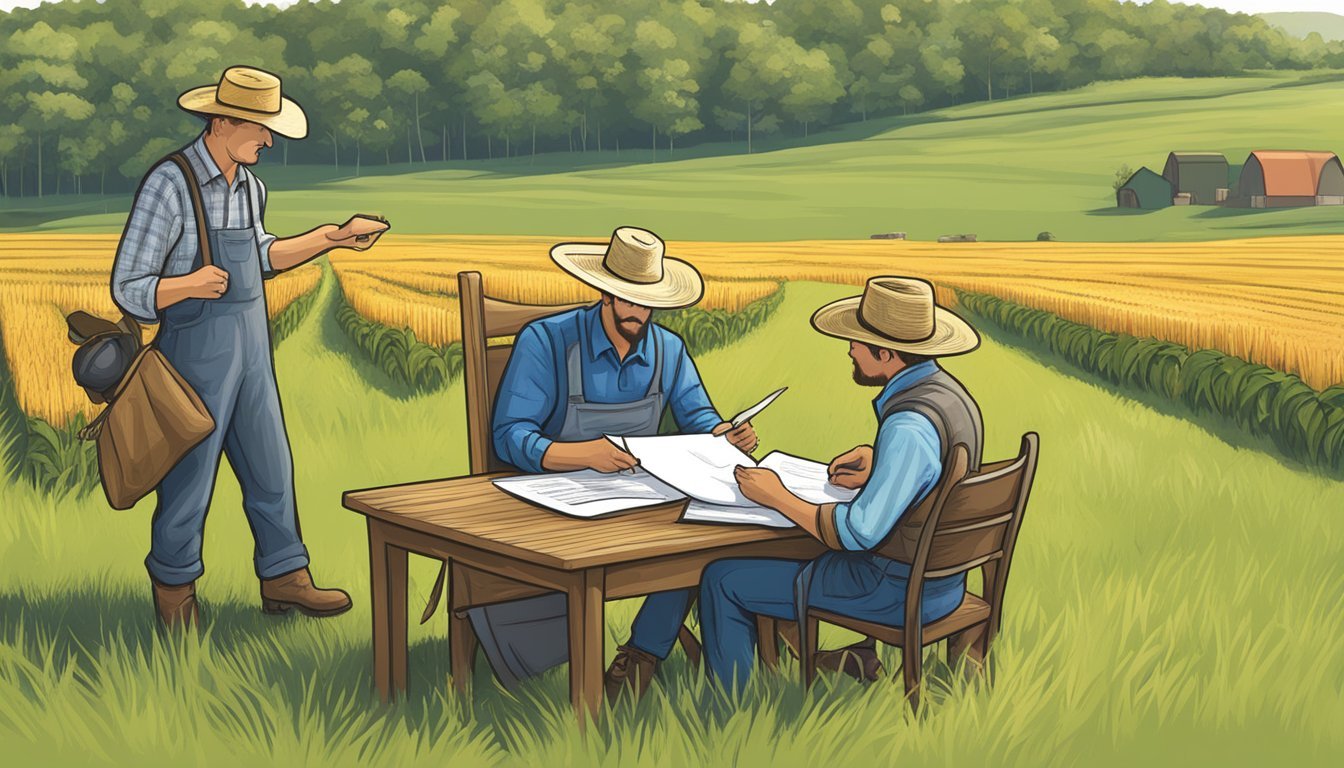Minnesota Farm Land for Lease
Opportunities for Agricultural Ventures
This Article is Part of Our Guide on Navigating Agricultural Leases Across the US
Minnesota's rich agricultural heritage has fostered a robust market for leasing farmland. The state's diverse climate and fertile soils are well-suited for a variety of crops and livestock, making it an attractive place for existing farmers looking to expand and new farmers seeking entry into the industry. Leasing land provides a more accessible alternative to outright purchasing, which can be particularly beneficial for those looking to manage costs or without the means for a significant initial investment.
The structure of farm land leases in Minnesota can vary significantly depending on the needs of the landowner and the lessee. These agreements range from straightforward cash-rent leases to more complex arrangements like flexible leases that tie rental rates to commodity prices or yields. Irrespective of the type, all parties must clearly understand their rights and responsibilities, ensuring a fair and equitable partnership.
A multitude of resources exist to connect landowners with prospective lessees. Services such as Minnesota FarmLink offer listings for available land, while other platforms provide updates on land leases and market prices. For those interested in leasing farm land in Minnesota, engaging with these services and consulting with real estate experts in the agricultural sector is an essential step in finding a suitable property that aligns with their farming objectives.
Understanding Farmland Leasing in Minnesota
In Minnesota, farmland leasing involves a variety of agreements and rental rates that cater to both property owners and farmers. It is essential to grasp the basics of leasing, types of leases, how rental rates are determined, and the essential components of a lease agreement.
Basics of Farmland Leasing
Farmland leasing in Minnesota is a common practice where landowners offer their property to farmers for agricultural production. As ownership and leasing vary, many farmers lease some or all of the land they farm. A farm lease is a legally binding agreement granting use of the land for farming.
Types of Farm Leases
Farm leases in Minnesota typically fall into two main categories:
Fixed Cash Leases: Tenants pay a set amount per acre or lump sum regardless of farm yield or price.
Flexible Leases: Rent is not a set amount but can vary based on variables such as yield, prices, or gross revenue. These often include a base rent with added bonus for high yield or price.
Determining Rental Rates
The cropland rental rate is influenced by several factors:
Land quality and location
Previous land rents
Current market conditions
While base rents in Southern Minnesota could range from $100 to $200, they are not fixed and can be influenced by the aforementioned factors. These rates are often used as guidelines and are not prescriptive of new lease agreements.
Lease Agreement Essentials
A proper lease agreement should cover the following essentials:
Duration: Specifies whether it's for a crop year or a longer term.
Payment Terms: Outlines how and when rent will be paid, including details of any flexible components if applicable.
Rights and Responsibilities: Delineates the tenant's and landlord's obligations towards the land.
A written lease is typically required for terms exceeding 12 months, ensuring legal enforceability and clarity for both parties.
Regional Variations in Farm Land Leasing
In Minnesota, the leasing of farm land displays significant variations by location, type of land, and agricultural focus, particularly when comparing different counties, cropland to pasture leases, and the region-specific trends in the southern part of the state.
Differences by County
Each county in Minnesota may have different lease rates influenced by local economic conditions, soil fertility, and demand for land. Historically, rental data from 2018 to 2022 shows weighted average rental rates varying significantly by county. For instance:
Steele County: Higher rental rates due to more fertile soil.
Polk County: Lower rental rates reflecting different local demands and agricultural productivity.
Cropland Versus Pasture Leases
The lease rates for cropland and pasture land in Minnesota also differ dramatically. Cropland, primarily used for row crop production like corn and soybeans, (how long do soybeans last?) usually commands higher lease rates compared to pasture land, which is used for grazing livestock. Key differences include:
Cropland: Higher rent due to the revenue potential from crop yields.
Pasture: Lower rent aligned with the economics of livestock grazing.
Rental rates are influenced by the specific uses of the land, with cropland rent being influenced by crop prices and yields, while pasture rent is affected by livestock market conditions.
Southern Minnesota Focus
In Southern Minnesota, farm lease rates are particularly influenced by the region's agricultural intensity and the predominance of cropland suited for row crops. The data suggests that regions with a higher concentration of specific crop types can have notably different lease rates. As an illustration:
Counties like Blue Earth and Nicollet: Higher average cash rents.
Regions less suited for intensive crop production: More modest lease rates.
This variance is, in part, due to Southern Minnesota's favorable farming conditions, which allow for a prosperous agricultural industry compared to other regions of the state.
Crops and Commodities Impact on Leasing
In Minnesota, the type of crop grown has a significant influence on the leasing agreements for farmland due to the varied income potential and land use requirements. Commodities like corn and soybeans, which are prevalent in the region, can notably affect lease considerations.
Corn and Soybean Lease Considerations
Corn and soybeans are staple crops in Minnesota, making them central to discussions about land leases. Lease rates for these commodities tend to fluctuate based on market prices, input costs, and yield histories. When corn prices are above a certain threshold, such as $2.50, the cash rent may fall below 30 percent of the gross income, averaging around 21 percent. However, in years like 2013, significant increases in cash rent-per-acre were observed, which directly correlated with increased market values and gross income percentages.
One must also consider the cost of production for corn and soybeans when establishing lease rates. The expenses for seeds, fertilizers, pesticides, and operations contribute to the calculations that determine a fair lease rate, ensuring a balance between landlord revenue and tenant cost-effectiveness.
Other Crop Lease Factors
In addition to corn and soybeans, Minnesota farmland supports various other crops, including hay. Lease agreements for hay or other less common crops may differ, considering their market demand, profitability, and rotation practices. For example, a field consistently used for hay may experience less soil depletion and might fetch a different lease rate compared to those used for more nutrient-demanding crops.
Land quality also plays a crucial role in leasing decisions. Highly fertile cropland that consistently produces high yields of soybeans or corn may command higher lease rates as opposed to fields with lower fertility levels. Tenants and landlords must engage in thorough assessments of soil quality, past crop yields, and projected future yields to establish fair rental agreements.
Lease structure varies with the type of crop, too. For instance, flexible rent arrangements may be suitable for crops with high market volatility, where lease payments are tied to revenue levels, providing protection against unpredictable market shifts for both landlords and tenants.
Landowners and tenants can benefit from using tools such as historical data and cash rent worksheets provided by agricultural extensions to make informed leasing decisions. These resources help in understanding the particular conditions of a region and how they align with crop choice and commodity prices.
Economics of Farm Land Leasing
In Minnesota, the leasing of agricultural land is a significant component of the farming industry, influencing both the revenues of farmers and the value of farmland.
Calculating Gross Revenue
Gross Revenue for a farming operation is the total income generated before expenses are subtracted. When leasing farmland, tenants assess gross revenue to determine if rental costs are sustainable relative to the income the land can generate. This is generally calculated by taking the total acres of the leased land and multiplying it by the average yield per acre and current market price.
Assessing Farm Land Value
The value of farmland hinges on various factors, from soil quality to location. In assessing the value for leasing, one examines the land's potential for productivity and subsequent revenue generation. Historical data, such as past rental rates and yields, provide a foundation for setting current rates, ensuring they reflect fair market value.
Influence of Market Prices
Market prices of crops directly affect farmland rent dynamics. When agricultural commodity prices rise, rental rates may increase as the perceived earning potential of the land escalates. Conversely, lower commodity prices can dampen rental costs. Tenants and landlords often consider flexible leasing agreements, where the rent may fluctuate based on yield, gross revenue, or a combination of these factors, to account for market volatility.
Legal and Practical Aspects of Farm Land Leasing
Farm land leasing in Minnesota is subject to specific legal requirements with clear responsibilities for both landlords and tenants. These legal frameworks ensure smooth operations in the farming sector and provide a structure for conflict resolution, extensions, and renewals of lease terms.
Landlord and Tenant Responsibilities
Landlords are obliged to provide farm land that meets the agreed conditions and is suitable for the intended agricultural purposes. Tenants are responsible for maintaining the property in good condition throughout the lease term. Essential contact information should always be exchanged at the outset to facilitate clear communication.
Landlord's must-dos:
Ensure land suitability
Disclose known land defects
Maintain structural aspects of the property
Tenant's must-dos:
Use land appropriately
Report any issues promptly
Adhere to farming best practices as agreed
Contracts and Dispute Resolution
Lease agreements must articulate both parties’ obligations, the terms of the lease, and the mechanisms for dispute resolution. An effective lease should include:
Identification of all parties involved
Lease term with specific start and end dates
Rent details, including amount and payment schedule
Use of property specifications
Protocol for handling disputes
Disputes should first seek resolution through direct communication. If unresolved, the dispute may require mediation or legal arbitration as specified within the lease contract.
Extensions and Renewals
Lease extensions and renewals involve mutual agreement on terms and conditions for continued leasing. They must be documented in writing, especially if the extension surpasses 12 months. This documentation must include:
New termination date
Any changes in rent or other terms
Signatures of all parties involved
Extensions should be negotiated well before the current lease expires to ensure continuity of farming operations and legal compliance.
Additional Considerations for Lessees and Lessors
When engaging in a farm land lease in Minnesota, there are critical elements beyond the base terms of the lease that require attention. Both lessees and lessors must navigate insurance and liability, the use and improvement of farm buildings, and have clear strategies for lease termination.
Insurance and Liability
Lessees should ensure they have adequate insurance to cover operations and potential liabilities on the leased land. This typically includes property and casualty insurance that guards against loss or damage to crops, livestock, equipment, and structures. Lessors need to maintain their own insurance that specifically notes their status as a non-operating landowner to protect against personal liability risks.
Responsibilities:
Lessees: Obtain insurance for operations; may include crop, livestock, and equipment coverage.
Lessors: Update insurance to reflect non-operating landowner status; ensure coverage of landowner-specific risks.
Farm Improvements and Buildings
If the lease includes farm buildings, the agreement should specify who is responsible for maintenance and repairs. Improvements to the property by the lessee can also be a point of negotiation.
Key points:
Maintenance: Who will maintain and repair buildings, including costs and timelines?
Improvements: How will improvements be handled? Will the lessee be compensated for improvements that enhance land value?
Termination and Exit Strategies
The lease should clearly outline the process for termination, including notice periods and responsibilities upon exiting the lease. Both parties should create strategies to handle unexpected early termination, such as crop failure or changes in operational ability.
Termination details:
Notice: Required notice period for lease termination by either party.
Restoration: Conditions for restoration of property to its original state.
Clear agreements on these supplemental considerations will aid in creating a stable and prosperous relationship between lessees and lessors.
Opportunities in Minnesota Farmland Leasing
Leasing farmland in Minnesota presents a multitude of opportunities for both landowners and lessees, ranging from agricultural production to diversification and recreational use.
Agricultural Workshops and Support
In Minnesota, lessees can benefit from a number of agricultural workshops aimed at enhancing their farming knowledge and skills. The University of Minnesota Extension, for example, provides resources and education tailored to regional farming practices. These workshops are pivotal in keeping lessees informed about the latest agricultural techniques and can significantly impact productivity and sustainability on leased land.
Diversification Through Livestock and Dairy
Lessees have the opportunity to diversify their operations by incorporating livestock and dairy. This shift not only provides an additional stream of income but also contributes to land health through natural grazing patterns and nutrient recycling. Specialized dairy programs in the state can be leveraged by farmers to optimize milk production, ensuring that dairy-based endeavors are both profitable and sustainable.
Types of Livestock for Diversification:
Cattle for beef and dairy
Pigs for pork production
Poultry for eggs and meat
Recreational Uses and Supplementary Income
Farmland in Minnesota isn't limited to traditional farming alone. Land can be leased for recreational purposes, such as hunting, which is a popular activity in the state. This offers landowners an avenue for supplementary income while promoting wildlife conservation efforts. By designating areas of their land for hunting leases, landowners can attract a different clientele and tap into the state's vibrant outdoor sports culture.
Recreational Lease Opportunities:
Hunting: deer, turkey, waterfowl
Fishing in farm ponds and streams
Wildlife tours and photography sessions
Navigating the Farmland Lease Market
Navigating Minnesota's farmland lease market requires a detailed understanding of available resources, a strong network within the agricultural community, and the assistance of experienced real estate professionals. Engaging in these strategies can make the search for land for lease more efficient and can provide farmers with the opportunities they need to succeed.
Finding Available Land for Lease
Prospective lessees can locate land for lease by utilizing various tools such as university extension databases, online listings, and local classifieds. University of Minnesota Extension offers resources that include lists and spreadsheets of cropland rental rates, which reflect up-to-date information pertinent to the region and county. This can guide them in making informed decisions on rental prices for available acreage.
Tools and Resources:
University extension databases
Online agricultural real estate listings
Local newspaper classifieds
Networking and Building Relationships
Good relationships are central to securing farmland for rent. Farmers can benefit from reaching out to local agricultural associations and participating in community workshops. These connections lead to potential leads and offer insights into the local market dynamics. Building a rapport with existing landowners may also result in favorable lease terms.
Networking Channels:
Agricultural associations and cooperatives
Farm business management programs
Extension-hosted farmland rental workshops
Role of Real Estate Professionals
Real estate professionals with a focus on agricultural properties can be invaluable in the search for farmland. These agents provide services tailored to both landowners and farmers, including market assessments and paperwork management. Their expertise facilitates the lease process, from identifying potential land to finalizing the lease agreement.
Services Provided:
Market analysis and property valuation
Lease contract support and negotiation
Farmland location and acquisition assistance
Farmers in Minnesota looking for land for lease can leverage these strategies in the farmland lease market. By researching available land, cultivating industry relationships, and engaging real estate experts, they position themselves effectively in the competitive agriculture landscape.
Conclusion
In Minnesota, the leasing of farm land is framed by clearly defined contracts that transfer significant rights to tenants while protecting landowners' interests. With legal provisions in place, these contracts ensure both parties understand the terms of payment, possession, and control of the land.
Lease Types: Minnesota offers various lease agreements. These may range from fixed-payment leases to profit-sharing flexible agreements. The latter typically requires the landlord and tenant to share the profits from the farmland, mirroring a 50-50 crop share lease where yields and certain expenses are divided equally.
Determining Rent: Landowners should make data-driven decisions when it comes to setting rent. It entails reviewing historical data, considering the local going rate, and analyzing personal financial situations. For tenants, understanding these factors is just as crucial in negotiating fair lease terms.
Participation in Workshops: Attending workshops can be beneficial for both landowners and operators. They provide valuable insights into the economic landscape of farm leasing and help parties reach mutually beneficial agreements.
In terms of legal assistance, organizations such as the Farmers' Legal Action Group (FLAG) offer resources and support for those seeking to navigate the complexities of farm land leases in Minnesota. They can assist in ensuring that lease contracts are in accordance with state laws and that rights of both tenants and landowners are upheld.
In conclusion, leasing farmland in Minnesota is a collaborative process, requiring agreement on critical terms and understanding the local agricultural market. The fundamental goal is to establish a lease that serves the interests of both the landowner and the tenant in an equitable and lawful manner.








